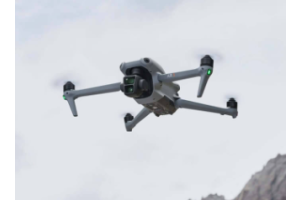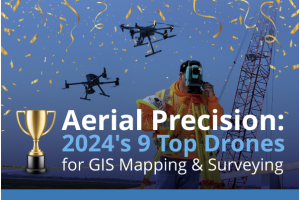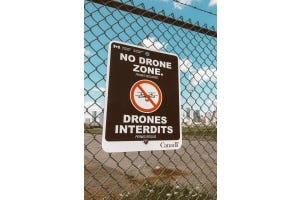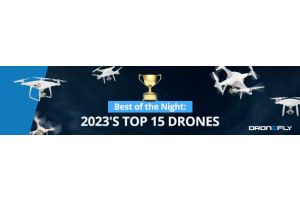
UPDATED: June 30, 2022
With a combination of endurance, performance, and innovative payloads, the DJI M300 RTK has set the bar for enterprise drones. In 2020, it was released alongside the Zenmuse H20, a hybrid multi-sensor camera solution for industrial and public safety operations. Soon after, the H20T, L1, and P1 arrived. The H20N, the most recent payload from DJI specifically designed for the Matrice 300 RTK, has a hybrid thermal, zoom, laser rangefinder, like the H20T. Want to know what makes the H20N so special? The 'N' is for night vision!
Starlight (Sensor), So Bright


With the N designator, the focus of the Zenmuse H20N is clearly on the night vision capabilities. This is made possible by the new Starlight sensor. With it's ultra sensitive sensor, it's great for low-light situations, whether you're on a search and rescue mission or securing an area after dark and needing to see critical information in the image.
Previous night operations with drones relied primarily on thermal imaging. However, there are many situations where thermal imaging is not the best option. During Search and Rescue missions, readings of surface temperature from a thermal sensor do not always provide the necessary information. They are open to interpretation, and operators can be misled by environmental factors, clothing, and even something as simple as a common mylar rescue blanket. These are just a few of the factors that make recognizing individuals in low-light settings an extremely difficult task.
The Starlight Sensors operate differently from the thermal sensors. To fully understand how, let's learn a bit about how light is measured, and how our naked eye can see in low light environments. Illuminance is the amount of light emitted by a specific region, and is measured in units of Lux (or the luminous flux per unit area). One Lux is equal to one lumen per square meter. When the light intensity falls below 20 Lux, the human eye has a hard time identifying objects.
In comparison to ordinary cameras, the Zenmuse H20N's Starlight sensors feature a larger aperture and a slower shutter speed, which increases the amount of light that's able to reach the sensor- resulting in improved clarity in dim lighting. Image noise is reduced and image quality is improved using the sensor in concert with custom algorithms
Both the Zoom and Wide cameras on the H20N feature the Starlight sensor. As soon as the Payload is put into Night Mode, IR parameters are adjusted and the lens' IR filter is activated. Operators can identify light sources as low as 0.0001 Lux using an advanced low-light enhancement algorithm, way beyond the capability of what the human eye can see alone.
Using a DJI M300 equipped with an Zenmuse H20N, you'll be able to see targets and objects of interest through the darkness like never before.


The H20N's Zoom Goes The Distance
The Starlight's night vision capability is integrated into a 4MP 20x hybrid optical zoom camera. This combination enables a variety of public safety and security applications, such as searching for missing individuals after dark, detecting trespassers, patrolling mines, construction sites, and other sensitive locations at night.
This technology is poised to have a huge impact in night-time Search and Rescue. High-resolution close-ups and identifiable photos in low-light environments promise to eliminate false positives, enhance resource deployment decisions, and significantly cut mission time.
Thermal Zoom Capability
The Zenmuse H20N incorporates not just one but two 640x512 thermal sensors to convey extensive infrared data, which complements the new Starlight capabilities. One of the thermal sensors has a 2x zoom, while the other has an 8x zoom- eliminating the need for continuous zooming.




By leveraging the zoom capabilities, you're now able to keep a safe distance while still being able to get extreme details to determine if the heat source is an animal, a person, or something else. This enhanced thermal imaging capability can save pilots valuable time when every second counts.
Split-screen Zoom
The H20N's true power becomes unleashed when the hybrid sensors are used together.
Using both the thermal and visual sensors simultaneously, operators can better see in difficult circumstances by zooming in on a split-screen. This adaptability is critical in low-light situations and when assurance is required before making operational decisions.
A Laser Rangefinder for Unrivaled Accuracy
H20N inherits the Laser Rangefinder from the Zenmuse's H20 and H20T. The rangefinder delivers precise coordinates of a location or item to an accuracy of +/- 1 meter, with a detection range of 3-1200m. PinPoint allows this capability at a moment's notice. An object's GPS coordinates, its distance from the aircraft, and its height are recorded in a single tap thanks to DJI's advanced sensor fusion algorithms.


Low light is no longer a concern while coordinating missions from above thanks to the H20N's Starlight sensors.
Built Tough




The DJI M300 RTK is one of the most durable drones in existence. It only makes sense that the newest payload would continue in this vain. With an IP44 rating and able to operate in temperatures from 50º C to -20º C, the H20N hybrid payload was created to support public safety and security operations in the most extreme weather conditions.
As drones are becoming increasingly important tools for emergency responders and inspection personnel, payloads must be tough enough to withstand any environment. The H20N meets this challenge head on
Zenmuse H20N vs H20T
The Zenmuse H20T and H20N share a lot of features. However, a few minor changes allow them to be optimized for varied mission conditions. Both the Wide and Zoom cameras of the H20N have Starlight sensors, which are better suited for low-light situations. There is no better option that the H20N when it comes to image clarity and the ability to recognize persons or objects in the dark.
However, in daytime operations the H20T is the winner when it comes to resolution. This is due to the H20N's Wide camera having a lower pixel count than the H20T's. To accomplish the H20N's remarkable low-light capabilities, each pixel must be larger in order to allow more light in. Both payloads use comparable CMOS sensors (1/1.8 versus 1/1.7), however the H20N has less pixels overall to improve low-light performance.
For thermal imaging from afar, the H20N's two thermal imaging cameras with hybrid zoom functionality increases the thermal sensor's observation distance greatly.
Which One Is Best For You?
The ideal payload for your use case will depend on the conditions and mission at hand. To learn more about the Zenmuse H20N and H20T and what's the best solution for your operations, contact our friendly drone experts online at Dronefly.com. You can reach us by dialing (877) 299-1075.
For more information on the DJI Zenmuse H20N, check out our video rundown below!







